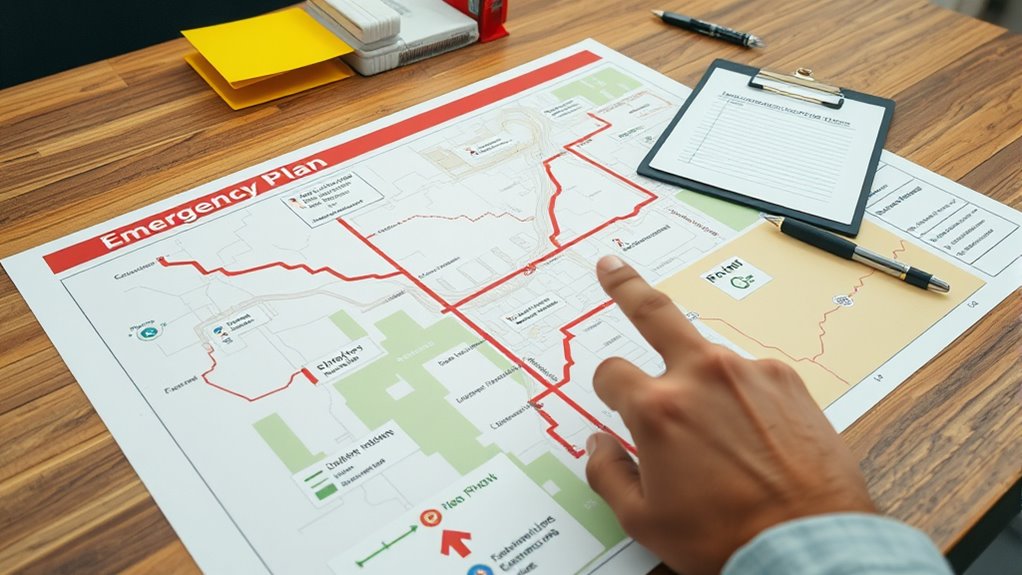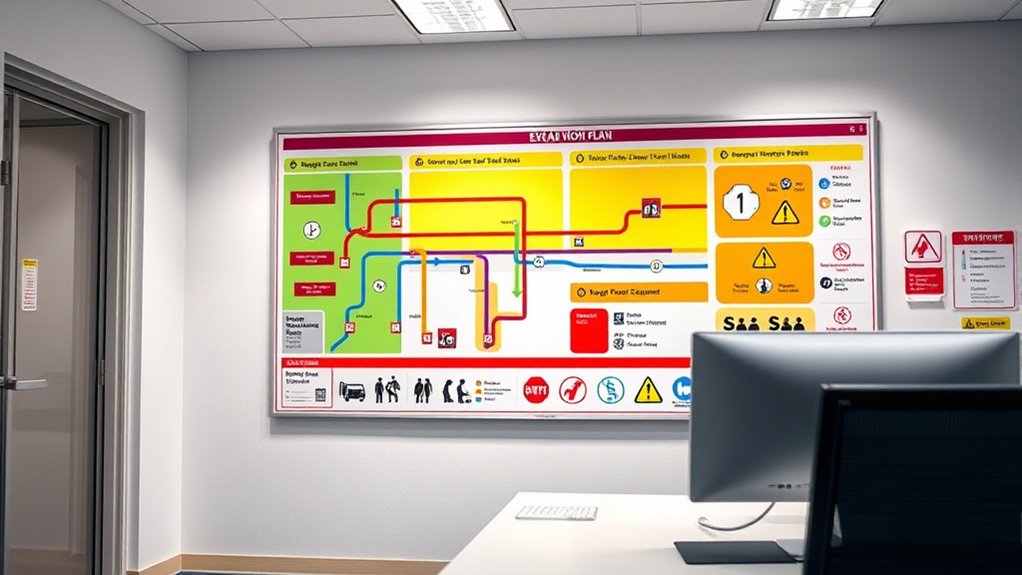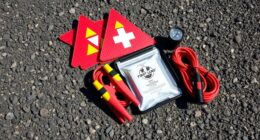To create effective evacuation and shelter plans, start by identifying multiple routes out of your neighborhood and designating safe meeting points. Prepare emergency supplies, including water, food, and medical kits, organized and accessible. Coordinate with neighbors and community resources, sharing plans and practicing drills. Establish clear communication channels, and know the locations of nearby shelters. Regularly review and update your plans to stay prepared—exploring these strategies further will help you feel more confident when emergencies happen.
Key Takeaways
- Identify multiple safe evacuation routes and familiarize all family members through regular practice.
- Designate primary and secondary shelter locations, ensuring they are accessible and known to everyone.
- Establish clear communication channels with neighbors and community resources for coordinated responses.
- Prepare organized emergency kits with essential supplies, keeping them easy to access during evacuations.
- Collaborate with local authorities and participate in community drills to test and improve your plans.

Are you prepared if an emergency strikes your community? The key to safety during unexpected events lies in creating solid evacuation and shelter plans. These plans ensure you and your loved ones know exactly what to do, where to go, and how to stay safe. To get started, focus on assembling extensive emergency supplies. Stockpile essentials like water, non-perishable food, first aid kits, flashlights, batteries, and necessary medications. Think about the specific needs of everyone involved, including pets, so your supplies are well-rounded. Keep these supplies accessible and organized in a designated emergency kit, making it quick to grab when needed. Regularly review and update your supplies to account for changing needs and expiration dates. Incorporating familiar and reliable storage solutions can help maintain order and accessibility in stressful situations.
Community coordination plays a pivotal role in effective evacuation planning. Engaging with neighbors, local authorities, and community organizations helps ensure everyone is on the same page. Share your plans with those around you and learn about theirs. Knowing nearby shelters and their capacities will help in choosing safe destinations during an emergency. Establish clear communication channels, such as group texts, social media groups, or community alert systems, so updates can be shared swiftly. Planning multiple routes out of your neighborhood can prevent bottlenecks and congestion, especially if some roads are blocked or damaged. Practice these routes periodically with family and neighbors so everyone is familiar with the safest and quickest options.
Community coordination ensures safe evacuations through shared plans, clear communication, multiple routes, and regular practice.
Designating a safe meeting point outside your home is vital. This spot should be easy to reach from multiple directions and known to all family members. In addition, identify a secondary shelter location in case your primary option becomes inaccessible. It’s equally important to prepare a detailed transportation plan. Depending on your situation, this might involve arranging for family members to have access to vehicles or coordinating with local emergency services for assistance if needed. Make sure everyone knows how to evacuate quickly and calmly, avoiding panic.
Finally, incorporate community resources into your plans. Local emergency management agencies often provide guidance, training, and resources for residents. Participating in community drills can help you test and refine your evacuation and shelter strategies. The more you practice, the more confident you’ll feel in executing your plan when it’s truly needed. Building familiarity with home organization techniques can streamline your preparations and response efforts. By focusing on well-planned emergency supplies and fostering strong community coordination, you’ll greatly improve your chances of staying safe during a crisis.
Frequently Asked Questions
How Often Should Evacuation Plans Be Reviewed and Updated?
You should review your evacuation plan at least once a year and update it whenever there are significant changes, such as new building layouts or staff. Establish an update schedule to guarantee your plan remains effective and relevant. Regular plan review helps identify gaps, incorporate lessons learned, and adapt to evolving risks, so it’s vital to stay proactive. Consistent updates keep everyone prepared and ensure safety during emergencies.
What Training Is Necessary for Staff Involved in Evacuation Procedures?
You should guarantee staff involved in evacuation procedures receive thorough training on emergency protocols, including regular staff drills. These drills help staff familiarize themselves with evacuation routes, shelter locations, and communication procedures. Training should be ongoing, with refresher sessions at least annually, to keep everyone prepared and confident during emergencies. Proper training minimizes confusion, speeds up evacuation, and ensures everyone’s safety in critical situations.
How Do Plans Differ for Specific Emergencies Like Floods or Earthquakes?
You tailor flood response and earthquake preparedness plans to address each emergency’s unique challenges. For floods, focus on quick evacuation routes and safe shelter locations above flood levels. For earthquakes, emphasize secure furniture, drop, cover, and hold procedures. You adjust communication strategies accordingly, ensuring staff know how to respond promptly. By customizing your plans, you improve safety and minimize risks during these specific emergencies.
What Communication Methods Are Most Effective During an Evacuation?
Think of emergency communication as your lifeline in chaos; it keeps everyone connected like a web of safety. You should prioritize clear, direct messages via multiple channels—like alerts, social media, and radio—to reach everyone swiftly. Technology integration is crucial, ensuring updates are real-time and accessible. You must act quickly and stay informed, so your evacuation stays organized and safe, no matter what disaster strikes.
How Can Shelters Accommodate Individuals With Special Needs?
You can guarantee shelters accommodate individuals with special needs by incorporating accessibility features like ramps, wide doorways, and visual signage. Additionally, provide medical accommodations such as designated spaces for medical equipment and trained staff to assist with mobility or health issues. You should also communicate clearly about available resources, making sure everyone understands how to access assistance, so all individuals feel safe and supported during an emergency.
Conclusion
By now, you understand the importance of well-crafted evacuation and shelter plans. Did you know that over 50% of people aren’t prepared for emergencies? Don’t wait until it’s too late—review your plans regularly, practice drills, and stay informed. Being proactive means you’re more likely to stay safe when disaster strikes. Remember, a small effort today can make all the difference tomorrow. Stay prepared, stay safe, and keep your plans up to date.









